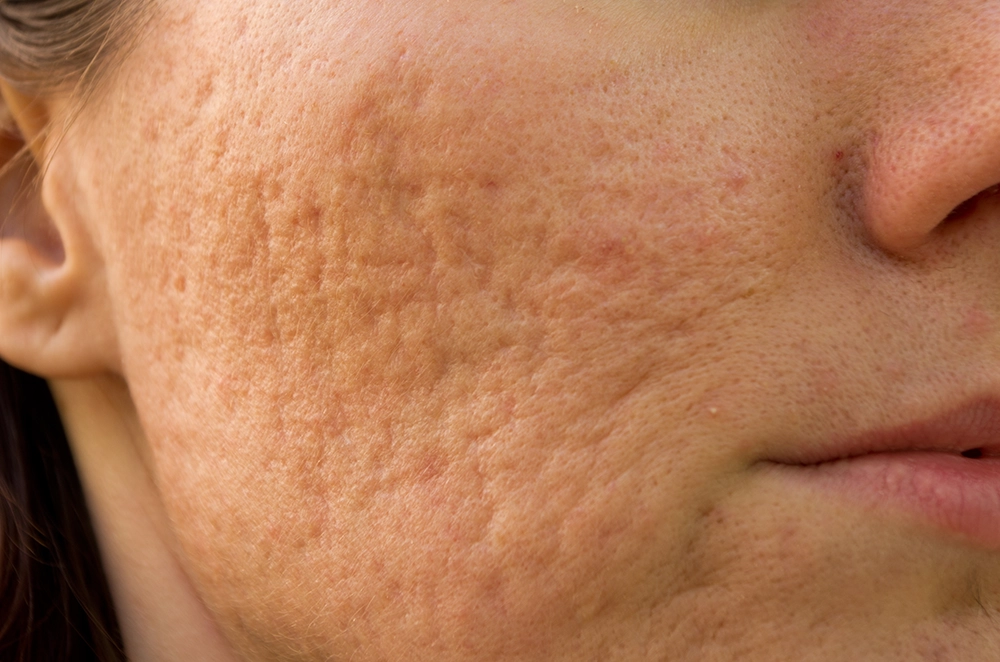Air Subcision

Depressed to Dazzling: Embracing Air Subcision for Smoother Skin
Acne scars can be a lasting reminder of past breakouts, affecting self-confidence and overall skin appearance. Among the different types of acne scars, depressed or atrophic scars are the most common.
Thankfully, there are treatments available, including air subdivision, which is designed to release tethered scars and smooth the skin.
In this article, we’ll explore just how air subcision works, its benefits and how you can maintain results after treatment.
Types of Depressed Acne Scars
Depressed acne scars form when the skin fails to regenerate enough collagen during the healing process, leaving indentations.
Depressed acne scars are classified into three main types:
- Ice pick scars: Narrow, deep scars that resemble small punctures in the skin.
- Boxcar scars: Broad, U-shaped depressions with well-defined edges.
- Rolling scars: Wave-like, shallow depressions caused by fibrous bands pulling the skin downward.
If any of these scars sound familiar, you might benefit from air subcision.
What is Air Subcision?
Air subcision is a minimally invasive procedure designed to treat depressed acne scars by breaking up the fibrotic bands that tether the scar tissue to the deeper layers of the skin. Unlike traditional subcision, which uses a sharp needle or cannula, air subcision employs a high-pressure stream of air to release the scar tissue. This stimulates collagen production and promotes skin remodeling for a smoother complexion.
The procedure is particularly effective for rolling and boxcar scars, as it lifts the depressed areas and enhances the skin’s natural healing process. Air subcision can be combined with other acne scar treatments, such as microneedling, fractional lasers and fillers, to improve results.
The Air Subcision Procedure
Consultation and Assessment
The doctor evaluates your skin type, scar severity, and treatment goals to determine if air subcision is suitable for you.
Preparation
The treatment area is cleansed, and a topical numbing cream is applied to ensure comfort during the procedure.
Air Subcision Process
Using a specialised device, the doctor directs a high-pressure jet of air beneath the skin to break up fibrotic scar tissue and stimulate collagen regeneration.
Recovery Guidelines
The doctor provides post-treatment care instructions to ensure proper healing and maximise results. (More on this below.)
Benefits of Air Subcision for Acne Scars
Air subcision offers several advantages:
Minimally invasive
Effective collagen stimulation
Safe and precise
Immediate and progressive improvement
Compatible with other treatments
Post-Treatment Care and Recovery
After undergoing air subcision, proper aftercare is crucial to ensure optimal healing and prevent complications.
- Avoid touching or massaging the treated area: This helps prevent unnecessary irritation or disruption of the healing process.
- Apply a gentle moisturiser and sunscreen: Keeping the skin hydrated and protected from UV exposure minimises inflammation and supports recovery.
- Expect mild redness and swelling: These side effects typically subside within a few days.
- Avoid strenuous activities: For the first 24-48 hours, limit activities that may cause excessive sweating or irritation.
- Follow up with your doctor: Regular check-ins ensure that healing is progressing as expected and additional treatments can be scheduled if needed.
Maintaining Results
To maintain and enhance the results of air subcision, you should follow a consistent skincare regimen and, if necessary, go for complementary treatments.
- Use collagen-boosting skincare: Incorporate products with ingredients like vitamin C, retinol and peptides to support collagen production.
- Stay hydrated and follow a balanced diet: Nutrient-rich foods and adequate hydration help maintain healthy skin and optimise healing.
- Consider additional treatments: Combining air subcision with laser resurfacing, microneedling or dermal fillers can further refine results.
- Protect your skin from UV exposure: Sun protection is essential to prevent pigmentation changes and ensure long-lasting improvements.
When Should You Consider Air Subcision?
Air subcision is ideal for individuals who:
- Have moderate to severe rolling or boxcar acne scars.
- Are looking for a minimally invasive treatment with minimal downtime.
- Have tried other treatments with limited success.
- Want to enhance the results of microneedling laser therapy or dermal fillers.
- Prefer a natural collagen-stimulating approach to scar improvement.
If you are unsure whether air subcision is the right treatment for you, you should consult our doctors.
Consult DermClear for Air Subcision
Air subcision offers a safe and effective solution for those struggling with depressed scars. If you’re ready to take the next step in your skin transformation, schedule a consultation with DermClear today. Our aesthetic doctors specialise in personalised care, taking your lifestyle and health needs into consideration for every treatment.
Let DermClear help you regain confidence in your skin—book your appointment now!
Sculpt the Body You Want–Feel Confident in Your Skin
Our friendly team is looking forward to serving you. For urgent enquiries and appointment requests, please call the clinic directly.